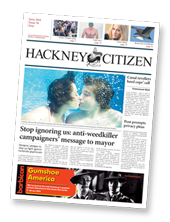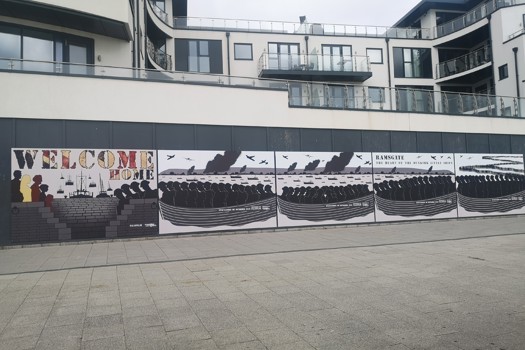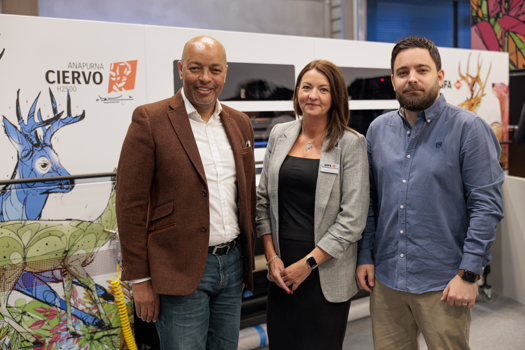Catering for our collective love of online hilarity, these of course represent the most farcical end of the scale. But for many, hilariously banal stories of this ilk also speak of a demise and disengagement with the kind of local reporting that used to be the very lifeblood of every community.
And yet this isn’t quite the whole picture. Certainly many a local newspaper has downsized, seen a decline in print circulation, transferred activity online or even, in the saddest cases, disappeared altogether. But there is in fact a new, very different generation of local publishers, and indeed local publication readers, now coming to the fore. And this generation are still, for the most part, surprisingly fond of print.
The term most often used in relation to this new breed is ‘hyperlocal.’ As this suggests, a great many reinvigorating the local news landscape currently are focused on very small geographical areas.
The reason is simple. As established newspaper publishers have struggled in tough times and pulled back their coverage, these typically very small, often one-man-band, hyperlocal outfits have sprung up to plug the gaps in the best way they can: by focusing their limited resources on what they know best.
Take the example of the Brixton Bugle, set up when the team behind it realised that the only newspaper catering for Brixton also covered the whole of south London.
“Brixton is a small area of wider south London and the only local newspaper is the South London Press,” says co-editor Tim Dickens. “That used to be absolutely brilliant, but of course with things as they are in the industry their weekly south London newspaper isn’t necessarily relevant anymore. If you live in Brixton, stories about Deptford and Greenwich are just not relevant to you.”
So the team set about establishing the Brixton Blog in January 2012, launching the monthly print version, the Brixton Bugle, in June of that year.
In this respect, the Brixton Bugle typifies much hyperlocal activity, reports Damian Radcliffe, a journalist and researcher specialising in hyperlocal media, citizen journalism and digital communities. The online publishing revolution has enabled small outfits to find their publishing feet, he explains, with many then going on to discover and fill the printed news gap left by the traditional local rag.
“I’d say it’s been in the last five or six years that we’ve seen a transformation in this space,” says Radcliffe. “That’s due to the ease with which people can now publish online using Wordpress or Ming. That removes a lot of the technical and cost barriers. And we’re increasingly also seeing people using group pages on existing social networks to provoke discussion.”
“Then we’ve seen print media grow back where there are gaps in coverage and increasing opportunities for entrepreneurs,” he continues. “That’s where local offices have perhaps been closed, with content being produced outside of the footprint of the actual publication itself.”
Print’s strengths
The average hyperlocal set-up is, then, still publishing in print for largely similar reasons to its rival established local paper. A key driver is of course ad revenue, with most local businesses still much keener on placing adverts in a tangible printed product than online.
“Local advertisers really understand print but they don’t seem very keen on advertising online,” confirms Keith Magnum, founder of small start-up paper, the Hackney Citizen. “What they like is a great big ad that they can show off to people. If advertisers see 10,000 newspapers going out it feels more measurable, whereas with a banner ad they’re slightly more concerned about who’s seeing it.”
Like the more thriving of their established paper counterparts, hyperlocal outfits are also typically recognising the need to reach the still digitally disenfranchised. “In our area there are a huge number who aren’t online. Or if they are they don’t consume their news there,” reports Dickens.
But for hyperlocal outfits, a printed product isn’t just about reaching a, perhaps older, digitally disenfranchised demographic. Print is also proving just the thing in reaching those who do consume news online but who wouldn’t know to go to a newly formed website, and who perhaps wouldn’t normally buy a local paper but are happy to read a freebie.
Thus a printed product becomes in fact more important to the average hyperlocal publisher than traditional outlets. Where a geographical area is being targeted, building awareness of a completely new brand is obviously trickier to do online than with a bit of strategically positioned print.
“There’s something very tangible about having the newspaper in your hands and I think that’s very good in terms of brand equity and raising awareness,” says Radcliffe. “You can reach a reader who might never come to your website, might never know that it exists. And for some audiences there’s also a credibility factor.”
The Brixton Bugle is one such printed paper that, through a proactive strategy of distributing outside Brixton Tube station and on local buses, is reaching a demographic new to local news. The Hackney Citizen is another.
“We did a readership survey last year and discovered we have a very different readership to a normal local paper: the average age range for us is 25-45 years old, which is younger than most papers’,” reports the Hackney Citizen’s Magnum. “71% of our readers read The Guardian or The Independent. So we have a completely unusual demographic, which is good for advertising.”
Having bucked the trend and started as a print edition and then launched online two years later, the Hackney Citizen is also a good example of how print is being favoured not just for the above accessibility, brand-building and ad revenue reasons. In some instances, producing a printed product is actually the more straightforward option.
“We were trying to build our own website and the timescales just slid so we just started printing,” reports Magnum of the Hackney Citizen’s 2008 launch.
“It’s very cheap to print now because unfortunately print still has more capacity than there is demand, so it’s a relatively cheap way for new outlets to get their message across,” reports Tracy Wright, managing director at Iliffe Print, a company working with a whole range of recently formed publishers, including the Brixton Bugle. This sort of work now accounts for 30% of Iliffe’s revenue.
The Hackney Citizen is also a good example of how the term ‘hyperlocal’ doesn’t quite take into account the wealth of local publishing activity now going on. Serving a whole borough – an area covered by a number of rival established papers – the paper wasn’t set up to plug a geographical gap. But rather a gap in the type of content being produced – specifically ‘in-depth’ coverage.
“A lot of these titles spring up from a strong civic need and desire to understand what’s happening at a local government level,” reports Radcliffe. “That’s an area local newspapers have arguably pulled back from quite a bit over the last 20 years. Your first job on a local newspaper used to be going to report on council meetings, but now the only people at council meetings are hyperlocal outlets.”
New local publications are also giving traditional local news a run for its money through a much greater emphasis on design. City of York-focused One&Other is one such title.
“We decided we wanted to design something beautiful and work with good photographers. We wanted to come up with something which celebrated the local culture,” says founding director Vicky Parry. “Whereas the traditional media are just focused on targets and pushing stories out, we think outside of the box. We look for things that are internationally exciting but with a York focus.”
A high-end print product is similarly central to the publishing strategy of monthly local lifestyle magazine HU17, which covers Beverley in Yorkshire. Founder Paul Smith rejects ‘bad news’ news values in favour, again, of celebrating the local community. For him this means a glossy, highly image-based product.
“Everyone can upload a picture to Facebook now, so a picture on the internet isn’t special,” he says. “But to be in print is still special. When I launched the magazine I saw a decline in my photograph sales because people would rather have their picture as part of a magazine or paper.”
“People just love to look at pictures of people they know in print,” adds Smith. “You’ll go into bars and there’ll be women sat around a table looking at the magazine, seeing what people are wearing, seeing who’s with who.”
Newspaper and magazine printers wanting to insulate themselves from the decline of traditional local publishing, will need too to be aware of outlets serving communities other than purely geographical ones.
Iliffe’s Wright counts not just local and hyperlocal set-ups among his client base, but several foreign-language papers serving immigrant populations too. The best term to encompass all the activity going on in this area is ‘micro-publishing’, he feels.
Limited resources
But diverse as micro-publishers are, the two things they all have in common are limited resources and limited expertise in ordering print.
The majority don’t have a background in journalism, and so have plenty of new challenges to contend with besides just ordering print. Even those with a journalistic background, such as the Brixton Bugle’s Dickens, won’t necessarily have held a production role. And all consist of tiny editorial and sales teams.
“We still haven’t achieved a fully sustainable ad rate, so the model still relies on people chipping in without necessarily getting paid for it,” reports Dickens. “We have six editors but not editors in a traditional sense in that they all also have full-time jobs. So they do this in the evenings.”
“Our printers, Buxton Press, have to make ordering print super easy because we are silly busy and are trying to do more than we can,” adds One&Other’s Parry.
Wright confirms that working with very small, often part-time, teams, requires a lot of handholding on the printer’s part.
“The issue for us as the printer is that these people are very enthusiastic but not that knowledgeable about printing so it means we need to be a lot more customer focused than we were,” he says. “We have to go out there and help them put a newspaper together and optimise its quality. So we have a service for instance where they send the pictures, we optimise them and then send them back to put in the page.”
Whether hyperlocal and micro start-ups remain fairly informal, small operations remains, however, to be seen. Not surprisingly the rise of hyperlocals has piqued the interest of traditional local news outfits.
“There was an example recently of Epping Forest partnering with Archant and I think that’s a model that could become very interesting in the future,” says Radcliffe. “Where newspaper groups are pulling back slightly from some of their print products they could partner with hyperlocals. That might be replicated in other parts of the UK.”
But Radcliffe is also alert to the possibility of things not panning out this way. Many hyperlocal and micro publishers are after all motivated by disillusionment with the traditional local paper, and passion for serving their local communities. So it’s perhaps unlikely many will want to hand back the local publishing reins.
Brixton’s Dickens is certainly sceptical of the idea. “We’ve been approached by various regional publishers who have said ‘we like what you’re doing, is there any way you could help produce content for us and help us interact on a hyperlocal level?’ But to be honest, I never think there’s anything in it for us,” he says.
It seems, then, that the less formal local publishing outfit could be here to stay. This means magazine and newspaper printers wanting to get involved may need to adopt a much more hands-on, customer service-oriented approach.
While the newspaper is typically heralded as an obvious victim of the digital age, this doesn’t quite reflect activity at a local level. Beavering away behind the more widely reported plummeting local news circulation figures, are plenty of guerilla, non-traditional journalists passionately reinvigorating their local communities. And although the internet age has certainly allowed these self-appointed journos to get going, it’s print that’s enabled them to go from strength to strength.
Case study: Hackney Citizen
 The Hackney Citizen was launched as a quarterly printed publication in 2008. It is now published monthly, with a circulation of 10,000. An accompanying website was launched in 2009.
The Hackney Citizen was launched as a quarterly printed publication in 2008. It is now published monthly, with a circulation of 10,000. An accompanying website was launched in 2009.
“The paper grew out of pub talk saying ‘Hackney needs a local paper where the issues are debated better’,” says founder and editor Keith Magnum. “Our most direct rival the Hackney Gazette has been going for over 100 years and we’ve been going just six, so obviously we need to be doing different things, and there’s no value in just doing crime all over again.”
“We struggle with breaking news because we’re so small but we do more in-depth investigations. So we tend to focus on community issues and contentious planning and development issues.”
The Hackney Citizen also differentiates itself through targeting more of a young professional demographic. “We saw that the borough was changing and we thought there was space for high-quality local news in a better format; we thought we could reinvigorate the local newspaper format,” says Magnum.
The team has also just launched an arts title the East End Review, also with a 10,000 circulation. It plans to launch another paper for the borough of Tower Hamlets: the East End Citizen.
“We think three is the right number of papers to survive,” says Magnum. “It’s still not clear to me that hyperlocal can survive financially long term; we think you have to be at least as large as a borough to survive. And we’ve really struggled, we’ve only just come out of the woods.”
Magnum reports that the operation is always looking for extra revenue streams, including a small journalism school it has been running for two years.
As a small team consisting of Magnum, a full-time arts and culture editor, a part-time news editor and three part-time sales execs, the paper relies heavily on close support from its printer, Mortons of Horncastle.
“Mortons really helped with image correction at the beginning, as on newsprint, pictures can be quite muddy and washed out,” says Magnum, adding: “When we first started we really struggled to get our PDFs up on FTP and sometimes they’d be three hours late. Mortons were incredibly patient with us.
“I’m not a journalist and I’ve never been in business before so this is very much a leap in the dark,” he adds.










